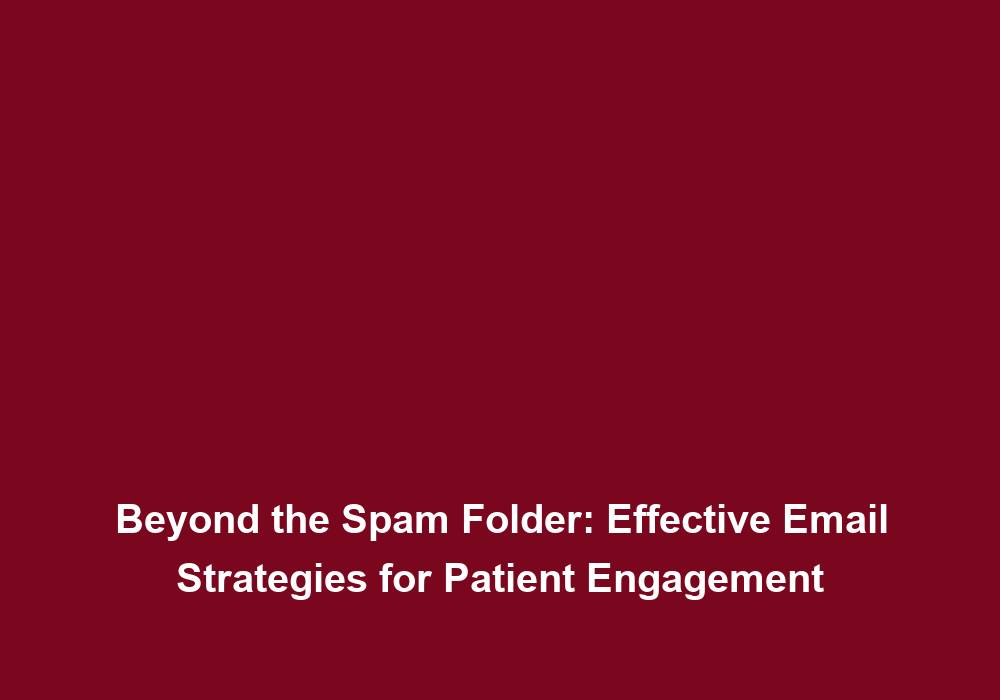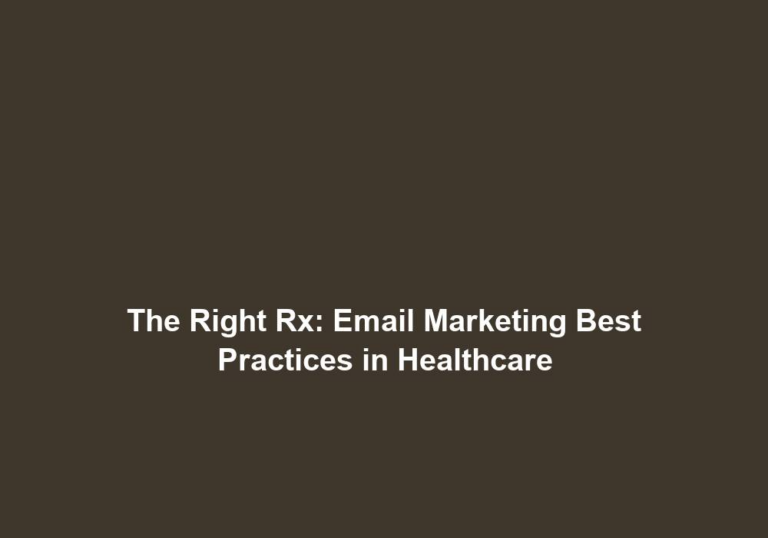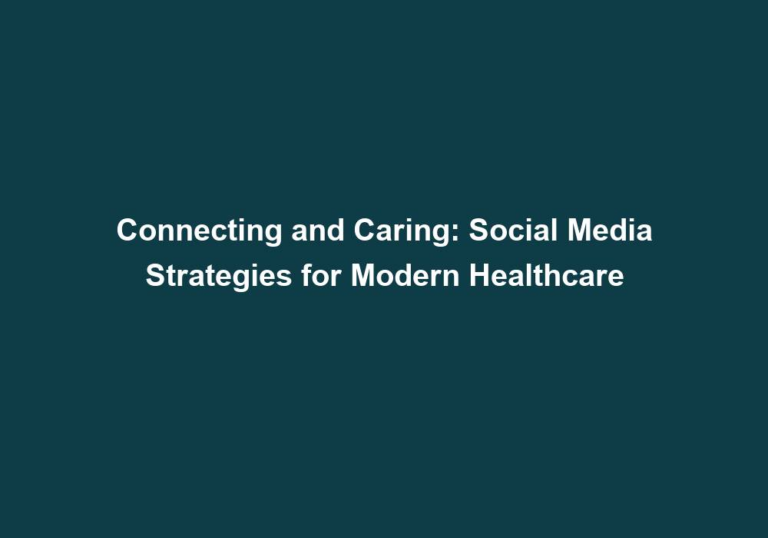Beyond the Spam Folder: Effective Email Strategies for Patient Engagement
In today’s healthcare landscape, effective patient engagement is crucial for healthcare providers to build strong relationships with their patients and ensure optimal care. Email marketing has emerged as a powerful tool for engaging patients and keeping them informed about their health, appointment reminders, educational materials, and more. However, with the increasing spam filters and overwhelming volume of emails, it is essential for healthcare practitioners to adopt effective strategies to ensure their emails are not lost in the abyss of the spam folder but instead reach and engage their intended recipients. In this article, we will explore some tips and best practices for crafting engaging and impactful emails that go beyond the spam folder to effectively engage patients.
Understanding Email Deliverability
Before diving into the strategies, it is crucial to understand the concept of email deliverability. Email deliverability refers to the ability of an email to reach the intended recipient’s inbox. Several factors influence email deliverability, including sender reputation, email content, recipient engagement, and more. It is paramount to optimize these factors to maximize the chances of your emails landing in the inbox rather than being flagged as spam.
Building a Solid Sender Reputation
- Authenticate Your Emails: Implement email authentication protocols like SPF (Sender Policy Framework), DKIM (DomainKeys Identified Mail), and DMARC (Domain-based Message Authentication, Reporting, and Conformance) to prevent spoofing and verify your identity as a legitimate sender.
- SPF ensures that the receiving mail server can verify that the email originated from an authorized server, reducing the chances of your emails being marked as spam.
- DKIM adds a digital signature to your emails, allowing the recipient’s mail server to verify that the email hasn’t been tampered with during transit.
- DMARC combines SPF and DKIM to enhance email security and further establish your sender reputation.
- Maintain a Clean Email List: Regularly clean your email list by removing inactive or bouncing email addresses. This helps improve deliverability and ensures that your emails are reaching engaged recipients.
- Regularly scrubbing your email list helps to maintain a high deliverability rate by eliminating invalid or non-responsive email addresses.
- Use email verification services to identify and remove email addresses that are no longer active or have a high bounce rate.
- Avoid Sending Unsolicited Emails: Only send emails to individuals who have opted in to receive communication from your healthcare organization. Sending unsolicited emails can harm your sender reputation and increase the likelihood of your emails being marked as spam.
- Implement a permission-based email marketing strategy to ensure that you are only sending emails to individuals who have explicitly given consent to receive communication from you.
- Provide clear opt-in options on your website and other touchpoints to allow patients to sign up for your emails voluntarily.
- Monitor and Respond to Spam Complaints: Actively monitor and address spam complaints or unsubscribe requests promptly. Ignoring such requests can negatively impact your sender reputation and deliverability.
- Set up a dedicated email address for handling spam complaints and unsubscribe requests to ensure that they are promptly addressed.
- Regularly review and analyze the feedback received from spam complaints to identify any issues with your email content or sending practices.
Crafting Engaging Email Content
- Personalize Your Emails: Address your patients by their name and tailor your content based on their preferences, demographics, and medical history. Personalization creates a sense of connection and enhances the likelihood of patient engagement.
- Use merge tags or dynamic content to automatically insert the recipient’s name in the email greeting.
- Leverage your patient database to segment your emails and deliver personalized content based on their specific needs and interests.
- Clear and Concise Subject Lines: Write subject lines that accurately reflect the content of the email and pique the recipient’s interest. Avoid using deceptive or clickbait subject lines, as they can lead to your emails being marked as spam.
- Keep your subject lines short and to the point, highlighting the most important information or value proposition.
- Use action-oriented and compelling language to entice recipients to open your emails.
- Engaging and Relevant Content: Provide valuable and relevant information to your patients. This can include health tips, educational materials, announcements about new services or treatments, and reminders for upcoming appointments. The content should be concise, easy to read, and visually appealing.
- Use a conversational tone to make your emails more engaging and relatable.
- Incorporate multimedia elements such as images or videos to enhance the visual appeal of your emails.
- Include informative bullet points or lists to break up large blocks of text and make the content more scannable.
- Avoid Excessive Use of Capitalization and Exclamation Marks: Using excessive capitalization or exclamation marks in your emails can trigger spam filters. Use them sparingly and only when necessary.
- Limit the use of capitalization or exclamation marks to emphasize important points or calls-to-action.
- Use proper grammar and punctuation to maintain a professional and trustworthy tone.
- Optimize for Mobile Devices: Ensure that your emails are mobile-friendly and display correctly on various devices. A large portion of email recipients access their emails on smartphones or tablets, and a poorly optimized email may result in a negative user experience.
- Use a responsive email design that automatically adjusts the layout and formatting based on the recipient’s device.
- Test your emails across different devices and email clients to ensure a consistent experience for all recipients.
- Include a Clear Call-to-Action (CTA): Every email should have a clear and compelling CTA that directs patients to take action. Whether it is scheduling an appointment, accessing a patient portal, or contacting your healthcare facility, the CTA should be prominent and easy to follow.
- Use visually appealing buttons or hyperlinks to make your CTAs stand out.
- Clearly communicate the benefit or value proposition of taking the desired action to motivate recipients to engage.
Monitoring and Analytics
- Track Email Engagement Metrics: Regularly monitor and analyze key email engagement metrics such as open rates, click-through rates, and conversions. This helps you understand the effectiveness of your email campaigns and make data-driven improvements.
- Use email marketing software or analytics tools to track and measure the performance of your emails.
- Identify trends and patterns in the data to optimize your email content, subject lines, and sending frequency.
- Segment Your Email Lists: Divide your email list into specific segments based on demographics, medical conditions, or interests. This allows for targeted email campaigns that resonate with each segment, resulting in higher engagement rates.
- Use the data you have about your patients to create meaningful segments that enable you to deliver personalized and relevant content.
- Customize your emails to address the specific needs and interests of each segment, increasing the chances of engagement.
- Perform A/B Testing: Experiment with different email subject lines, content formats, and CTAs to identify the most effective strategies. A/B testing allows you to compare performance and optimize your emails for better engagement.
- Split your email list into two groups and test different variations of your emails to see which performs better.
- Test one element at a time (e.g., subject line, CTA, layout) to isolate the impact of each variation.
- Monitor Spam Complaints and Deliverability: Keep an eye on spam complaints and email deliverability rates. Identify any issues or trends that may be negatively impacting your email deliverability and take appropriate measures to address them.
- Regularly review feedback loops and spam complaint reports provided by email service providers.
- Investigate any sudden changes in deliverability rates and take corrective actions, such as adjusting your sending practices or improving email content.
In conclusion, effective email strategies play a vital role in patient engagement for healthcare providers. By understanding email deliverability, building a solid sender reputation, crafting engaging content, and monitoring email analytics, healthcare organizations can overcome the challenges of spam filters and ensure their emails reach and engage patients effectively. Implementing these strategies will not only improve patient satisfaction but also drive better health outcomes and strengthen the provider-patient relationship.





